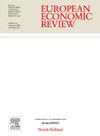Eurozone economic integration: Historical developments and new challenges ahead
IF 2.4
2区 经济学
Q1 ECONOMICS
引用次数: 0
Abstract
The paper yields a structural account of economic integration in the Eurozone from its inception to post-pandemic developments by considering a broad range of convergence measures. We introduce a novel FAVAR framework, extracting the structural shocks driving the Eurozone business and financial cycles directly from the cyclical components they generate. Productivity advancements have been the critical trend convergence factor, shaping long swings in real, labor market, and financial dispersion. Subdued cost-push shocks were the key driver of Eurozone nominal and competitiveness convergence throughout 2015 but have become an all-rounded divergence force since then. Fiscal discipline imposed by the Stability and Growth Pact (SGP) increased real and financial divergence during all recessionary episodes, while the ECB expansionary monetary policy was a convergence factor. The SGP suspension during the recent pandemic recession and recovery has partially counteracted divergence pressures. Looking forward, convergence will crucially depend on how productivity dynamics and economic growth will fend off further unfavorable cost-push developments, which might become pervasive in a deglobalization-driven new macroeconomic regime.
欧元区经济一体化:历史发展与新挑战
本文通过考虑广泛的趋同措施,对欧元区经济一体化从开始到大流行后的发展进行了结构性描述。我们引入了一个新的FAVAR框架,从它们产生的周期性成分中直接提取驱动欧元区商业和金融周期的结构性冲击。生产率的提高一直是关键的趋势趋同因素,形成了实际、劳动力市场和金融分散的长期波动。在整个2015年,低成本推动冲击是欧元区名义和竞争力趋同的关键驱动因素,但自那以来已成为全面分化的推动力。《稳定与增长公约》(SGP)实施的财政纪律在所有衰退时期都加剧了实际和金融差异,而欧洲央行的扩张性货币政策则是一个趋同因素。在最近的大流行经济衰退和复苏期间暂停SGP部分抵消了分化压力。展望未来,趋同将在很大程度上取决于生产力动态和经济增长将如何抵御进一步不利的成本推动发展,这可能在去全球化驱动的新宏观经济体制中变得普遍。
本文章由计算机程序翻译,如有差异,请以英文原文为准。
求助全文
约1分钟内获得全文
求助全文
来源期刊

European Economic Review
ECONOMICS-
CiteScore
4.70
自引率
3.60%
发文量
170
期刊介绍:
The European Economic Review (EER) started publishing in 1969 as the first research journal specifically aiming to contribute to the development and application of economics as a science in Europe. As a broad-based professional and international journal, the EER welcomes submissions of applied and theoretical research papers in all fields of economics. The aim of the EER is to contribute to the development of the science of economics and its applications, as well as to improve communication between academic researchers, teachers and policy makers across the European continent and beyond.
 求助内容:
求助内容: 应助结果提醒方式:
应助结果提醒方式:


